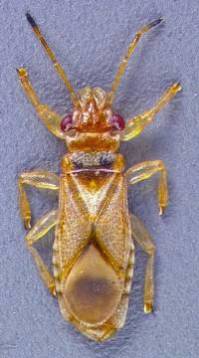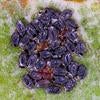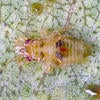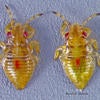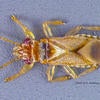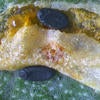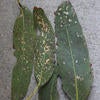Bronze Bug, Thaumastocoris peregrinus
Distribution: Native to Australia. Introduced into New Zealand, southern Africa, southern Europe, Mexico and S. America. In the U.S, T. peregrinus was first discovered in Los Angeles Co., California in June, 2016.
Field Identification: Adults (2.0-3.0 mm long) have orange/light brown flattened bodies with some dark brown areas. Eyes are red, bulging and pedicellate. Mandibular plates are strongly produced anteriorly. Tibiae with a unique lobate appendix (a structure enhancing their grasping ability to the substrate). Antennae are light brown with black tips.
Nymphs have tan to orange colored bodies with brown spots on their thoraxes and some abdominal segments. Eyes and the areas around dorsal abdominal scent glands are red. Eggs (about 0.5 mm long) are black, oval and flattened. They are usually deposited singularly or in clusters on the leaves and some smaller branches.
Hosts and damage: Attacks more than thirty species and hybrids of Eucalyptus and Corymbia, including the following widely planted in California trees: E. camaldulensis (Red Gum), E. globulus (Blue Gum), C. citriodora (Lemon-scented Gum) and C. maculata(Spotted Gum).
The foliage on affected trees may display leaf pitting, silvering and large areas of tan colored necrotic tissue. Heavily infested leaves often turn reddish-brown (bronzing) which can lead to defoliation and subsequent branch dieback. In some infestation sites extensive canopy thinning and tree mortality was recorded.
Bronze bug populations can build up quickly reaching pest proportions and may rapidly spread to nearby areas.
Center for Invasive Species Research, University of California, Riverside
Text provided by: Gevork Arakelian. Publication Date 15 September, 2016
Photos provided by: Gevork Arakelian
Gevork Arakelian, Senior Biologist, Los Angeles County Agricultural Commissioner/Weights & Measures Department.
GArakelian@acwm.lacounty.gov
Media within CISR is licensed under a Creative Commons Attribution-NonCommercial-NoDerivs 3.0 Unported License. Permissions beyond this scope may be available at www.cisr.ucr.edu/media-usage.
